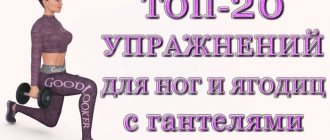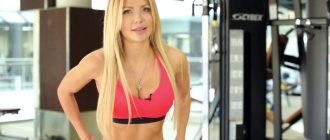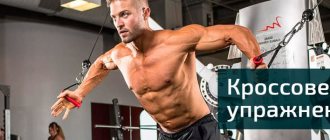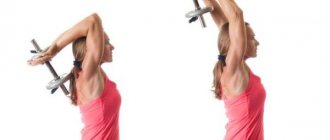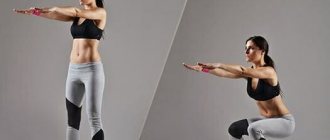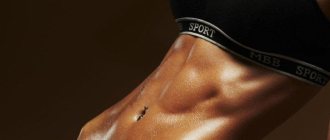Benefits of Exercise
The advantages of this type of training are the following:
- effectively affects the muscular system of the core (abdominal muscles, gluteal and dorsal region, shoulders and hips);
- exerts dynamic and static load on the press;
- reduces excess weight by promoting calorie burning;
- strengthens the cardiovascular system;
- can be performed in the form of a warm-up, which is aimed at warming up the muscles before performing other types of training;
- does not require special equipment, so the exercise is easy to perform at home.
Use in training
With the help of the “climber” you can burn from 8 to 15 kcal per minute. Of course, this is not enough for effective weight loss, so the element is included in comprehensive programs. We offer an example of a training plan designed to strengthen the muscles of the lower body and burn subcutaneous fat:
- Warm-up: jumping rope or walking on an elliptical - 5-7 minutes.
- Deep squats with jumping up - 3x20.
- Lunges with a bar on the shoulders - 3x15.
- Leg abduction to the side in a crossover - 3x15.
- Calf raises in a vertical machine - 3x20.
- Classic “mountain climber” - 3 sets of 30 seconds.
- Run on an electronic treadmill at an easy pace for 10–12 minutes.
The considered program is intended for girls. For men, we offer a strength training option:
- Warm-up: walking in an elliptical - 5-7 minutes, squats with your own body weight - 2x15.
- Leg press in the simulator - 3x10–12.
- Lunges with kettlebells - 3x15.
- Leg extension in a sitting machine - 3x12–15.
- Leg bending in a lying simulator - 3x12–15.
- “Climber” with ankle weights – 3x15.
- Roman chair crunches - 3x15.
We recommend using the programs in split workouts for the whole body. This way you will speed up getting rid of fat deposits and tighten your figure faster.
Technique, general rules for performing the exercise
Let's consider the classic version of running in a prone position:
- Take a horizontal position with your arms straight (like a push-up). Straighten your back, keep your head in line with your spine. Place your hands shoulder-width apart or slightly wider. Don't bend your elbows.
- As you exhale, bend one leg at the knee and pull it as close as possible to your chest. At the same time, try to tense your core muscles. The toe of the bent leg can be lowered to the floor or kept suspended.
- At the end point, pause for a few seconds. Inhale and return to the starting position. Repeat the movements, alternating lower limbs, and perform the required number of repetitions and approaches.
General recommendations for performing the “Climber” exercise:
- The abdominal and gluteal muscles should be in maximum tension. This ensures the effectiveness of the exercise and proper distribution of the load, and also prevents possible injuries and sprains.
- To reduce stress on the elbow joint and wrists, keep your arms straight. Bent arms reduce performance.
- The head should be kept in line with the spine. There is no need to allow it to be lowered or raised. This can cause serious neck injuries.
- If doing the exercise from the floor is difficult for you, you can make it easier. To do this, rest your hands on a small hill (bench, stool, etc.)
- The average number of repetitions is 15-20 times per leg for 4-5 approaches. If you are a beginner athlete, you should not initially train with increased loads. Start with 10 repetitions for 2 sets.
- The exercise should start at a slow pace and then gradually increase the intensity. Movements should not be sudden.
It is strictly not recommended for pregnant women or during menstruation to perform this workout. People with diseases of the cardiovascular system, especially those with hypertension, should approach exercise with caution. Athletes who have lower back injuries should first consult a doctor.
The classic version is in our video:
How to do it for weight loss: recommendations
In order for the plank to have a fat-burning effect, the exercise can be performed dynamically, increasing energy consumption. There are many options that can be performed separately or alternated with static techniques, thereby performing interval loading. For example:
- Raising your knees to your chest or running in a plank – 1 minute.
- Static elbow plank – 1 minute.
- Plank jumps back and forth – 1 minute.
- Static elbow plank – 1 minute.
- Plank rise from elbows – 1 minute.
- Straight arm plank in static position – 1 minute.
Read more about dynamic bars →
The complex can be performed 2-3 cycles. This option is suitable for trained athletes, but for beginners, the static plank can be replaced by lifting the body or jumping rope.
Short-term high-intensity interval training has a powerful fat-burning effect, while using a plank as an exercise - you can strengthen all the muscles of the body evenly.
Also read: Is it possible to pump up your abs with a plank? Plank every day: is it useful? Weight loss plank: table for a month →
Variations of the exercise
In addition to the classic running while lying down, there are several variations of this exercise, which are performed using sports equipment:
- Running while lying down with twists. Take a horizontal position. Hands slightly wider than shoulders. Straighten your back. As you exhale, bend your leg and reach your chest. Twist the waist a little to the side. Pull the bent leg towards the opposite shoulder. Inhalation is the starting position. Repeat with the opposite leg. In this version of the exercise, the main thing is to bend your waist to the side as much as possible. The main muscles are the abs and belt, the auxiliary muscles are the muscles of the buttocks and thighs.
- Exercise with an expander. The technique is identical to the classic version, only sports equipment is tied to the legs (just above the knee joint). The main load falls on the muscles of the buttocks, the secondary load is on the hip muscles.
- Two-legged running in a prone position. Starting position: lie down on the floor and straighten your arms at the elbows. As you exhale, simultaneously bend both knees and jump to your chest. As you inhale, take the original position. The main load falls on the abs, triceps and spinal muscles, the additional load falls on the core and deltoids muscles.
- The exercise can also be performed on a sports ball (fitball) or a bench. Execution technique: classic or with twists.
Is it possible to replace regular jogging by running in place?
Running in place is very different from regular running.
On the track, you also essentially remain in one place, but at the same time the canvas moves under you, which ensures. Is Motorized Treadmill Running Biomechanically Comparable to Overground Running? A Systematic Review and Meta‑Analysis of Cross‑Over Studies similar biomechanics of movements and energy expenditure. We were unable to find studies comparing muscle load between running in place and running. However, some assumptions can be made based on the characteristics of the movement.
When running in place, the load on the legs is reduced - especially on the buttocks and the muscles of the back of the thigh. After all, they do not need to strongly extend the hip at the end of the support phase, as happens when running forward.
In addition, when running in place, the body practically does not move, so the rectus abdominis and oblique muscles experience less stress, just like the rest of the muscles of the upper body - the arms and back.
If you run with a high hip lift—which is how this exercise is most often performed—the rectus rectus (quadriceps head) and iliopsoas muscles receive more load.
Due to the different muscle work and biomechanics of movements, the exercise is unlikely to help you improve your running technique. And you'll burn far fewer calories than doing the same cardio.
A more energy-intensive run with high knees will quickly hammer your calves and hip flexors, so doing this movement as a replacement for a long, quiet run won't work either.
But at the same time, the exercise still deserves a place in your training regimen. Especially if you prefer to study at home.
Common mistakes when doing the exercise
The most common mistakes that novice athletes make when performing this exercise:
- Deflection of the lower back and pelvis. Being in this position, the spine receives maximum tension, which increases the risk of injury. And the load on the press is significantly reduced.
- Active body movements. This not only reduces efficiency, but also makes training easier.
- Incorrect placement of the upper limbs. Hands should be placed at the correct distance. If the upper limbs are too wide, the maximum force will go to the shoulder joints. If the hands are placed close to each other, the load will be placed on the spine.
- Rocking of the hip joint. While bending your legs, try not to rock your pelvis. Movements should be in the plane of the body. This will create the necessary load on the press.
- Make sure that your knee does not touch the floor during movements. Weighted legs ensure the effectiveness of the workout.
- Incorrect breathing movements. Make sure you are breathing correctly. No delay allowed. As you exhale, make an effort, and as you inhale, return to the starting position.
If you don’t make mistakes and strictly follow the technique of running in a prone position, you will be able to achieve the desired result in a short time. If you can’t do this on your own, start training with a professional trainer at a fitness club, and after mastering the rules, continue training at home.
Why run in place?
This exercise is great for two purposes.
For warming up
Jogging in place can be used to warm up the same muscles that are used during regular running: the front and back of your thighs, calves, and feet.
If you're warming up indoors, you can alternate between easy running in place and high hip raises, and combine them with Jumping Jacks, dynamic stretching, and other active movements.
For HIIT and indoor cardio sessions
You can run very intensely in place to quickly raise your heart rate to 75–80% of the maximum value. This is useful for home interval complexes designed to pump up endurance and burn more calories in a short time.
At the same time, gentle jogging in place can be used for periods of active rest so that your heart rate doesn't drop too much, but you have time to catch your breath for the next intense interval.
Gymnastics and athletic training
144. Gymnastics and athletic training classes are aimed at developing agility, strength and power endurance, resistance to motion sickness and overload, spatial orientation, applied motor skills, cultivating courage and determination, and improving drill bearing.
145. Classes are held at gymnastics grounds, camps, in gyms or specially equipped rooms, on the decks of ships, at training complexes, and on the ground.
146. Gymnastics and athletic training classes include physical exercises on the horizontal bar, parallel bars, vaults, acrobatic exercises, exercises with weights, on simulators and multi-span apparatus, balance, climbing, outdoor games and relay races. For military personnel and cadets of military educational institutions training flight personnel, physical exercises on a trampoline, a stationary gymnastic wheel, and acrobatic exercises are included.
147. The section “Gymnastics and Athletic Training” includes the following exercises: Set of floor exercises No. 1 (the exercise can be used in the preparatory part of classes):
Set of floor exercises N 2 (exercise can be used in the preparatory part of classes):
Rice. 2. Complex of floor exercises N 2
Exercise 1. Flexion and extension of the arms while lying down (Fig. 3).
Lying support (legs together, straight body), bend your arms until your chest touches the floor, straightening your arms, take a lying support. The exercise is performed without stopping. To control touch, it is allowed to use a special technical device.
Rice. 3.Bending and extension of the arms while lying down
Exercise 2. Bend the torso forward (Fig. 4).
Lying on your back, hands behind your head, clasp your fingers, legs secured. Bend your torso forward until your elbows touch your knees and return to the starting position until your shoulder blades touch the floor. The exercise is performed for one minute. Slight bending of the legs is allowed.
Rice. 4. Bend the torso forward
Exercise 3. Rope climbing (Fig. 5).
Grasp the rope with your hands below the mark of 2 m from the floor and rise to a height of 6 m from the floor in an arbitrary manner. Touch the top mark with your hand. Lowering down is arbitrary. Pole climbing is permitted. It is prohibited to start the climb with a jump and jump from the rope above 2 m from the floor. The exercise is assessed according to the method of climbing: “excellent” – climbing without the help of legs, legs – in the “corner” position; “good” - climbing without the help of legs, legs - freely; “satisfactory” - climbing with the help of legs.
Rice. 5. Rope climbing
Exercise 4. Pull-ups on the bar (Fig. 6).
Hanging (overhand grip, legs together), bending your arms, pull yourself up (chin above the bar), straightening your arms, lower yourself into a hanging position. The hanging position is fixed. Slight bending and spreading of the legs is allowed. Jerking and swinging movements are prohibited.
Rice. 6. Pull-up on the bar
Exercise 5. Raising legs to the crossbar (Fig. 7).
Hanging (overhand grip, legs together), raise your legs to the bar until they touch and lower them down. The hanging position is fixed. Slight bending and spreading of the legs is allowed. Swinging movements are prohibited.
Rice. 7. Raising your legs to the bar
Exercise 6. Lifting by inversion on the crossbar (Fig. 8).
Hanging (overhand grip, legs together), bending your arms, raise your legs to the crossbar and turn around the axis to come to an emphasis on straight arms. After fixing the stop, lower yourself into a hanging position without stopping in an arbitrary manner. The hanging position is fixed. Slight bending and spreading of the legs is allowed. It is prohibited to perform swing movements and touch the crossbar with your chin.
Rice. 8. Lifting with a coup
Exercise 7. Power lifting on the crossbar (Fig. 9).
Hanging (overhand grip, legs together), bending your arms, place one bent arm at point-blank range, then the other; Continuing the movement, go into emphasis with straight arms, after fixing the emphasis, lower yourself into a hanging position without stopping in an arbitrary manner. The hanging position is fixed. Slight bending and spreading of the legs is allowed. It is prohibited to perform exercises on both arms and movements with a jerk or swing.
Rice. 9. Power lift on the bar
Exercise 8. Bench press (Fig. 10). The weight of the bar is 70 kg.
Lying on your back on a horizontal bench, with an overhand grip on the barbell of a barbell located on specially equipped racks, lift the barbell with straight arms, then bend your arms until your chest touches the barbell, while straightening your arms, perform a chest press of the barbell. After fixing the barbell on straight arms, repeat the next barbell press. The exercise is performed without stopping. The use of a reverse grip is prohibited. Any change in the starting position is prohibited: lifting the head, shoulders, buttocks from the bench and feet from the floor. It is allowed to rest in the initial position of the barbell at the top with straight arms. There are two weight categories: up to 70 kg, 70 kg and above.
Rice. 10. Bench press
Exercise 9. Bending and extension of the arms in support on the uneven bars (Fig. 11).
Emphasis on straight arms, bending your arms, lower yourself into emphasis on bent arms; straightening your arms, go straight to straight arms. The position of the support is fixed; when lowering, the arms are bent completely. Slight bending of the legs, body and leg extension are allowed. Swinging movements are prohibited.
Rice. 11. Bending and extension of the arms in support on the uneven bars
Exercise 10. Angle in support on the uneven bars (Fig. 12).
Focus on straight arms, raise straight legs and hold them horizontally above the poles. The time for performing the exercise is determined from the moment the “angle” position is fixed until the heels of the feet are lowered below the poles.
Rice. 12. Angle in support on uneven bars
Exercise 11. Kettlebell snatch (Fig. 13). The weight of the weight is 24 kg.
Stand with your legs apart, grab the handle of the weight from above with one hand, consistently lift the weight up and lower it down without touching the floor, first with one hand, then without rest after changing hands with the other. The position of the weight at the top is fixed on a straight arm, changing hands is carried out once during the forward swing. It is forbidden to press the weight, rest in a position where the weight is lowered down, or touch parts of the body with your free hand. There are two weight categories: up to 70 kg, 70 kg and above. The result is determined by the sum of jerks performed by each hand.
Rice. 13. Kettlebell Snatch
Exercise 12. Push of two weights (Fig. 14). The weight of the weight is 24 kg.
Stand with your legs apart, with an overhand grip on the arms of the weights, lift the weights off the floor, lift them to your chest, with the weights lying on your forearms and shoulders, your arms pressed to your body; push the weights up and fix them on straight arms, then lower the weights to your chest. It is prohibited to press weights or place weights on your shoulders. There are two weight categories: up to 70 kg, 70 kg and above.
Rice. 14. Push of two weights
Exercise 13. Push two weights in a long cycle (Fig. 15). The weight of the weight is 24 kg.
The kettlebell push consists of three techniques: the clean, the push from the chest, and the lowering to a hanging position. Stand with your legs apart, with an overhand grip on the arms of the weights, lift the weights off the floor, lift them to your chest, with the weights lying on your forearms and shoulders, your arms pressed to your body; push the weights up and fix them on straight arms. To repeat the cycle, lower the weights first to your chest and then down without touching the floor. It is prohibited to rest when lowering the weights to the chest. It is also prohibited to rest while holding the weights down. It is allowed to rest with weights on the chest after lifting them from a hanging position, as well as with weights fixed on straight arms after a push from the chest. It is forbidden to rest while holding the weights on the shoulder joints. There are two weight categories: up to 70 kg, 70 kg and above.
Rice. 15. Push two weights in a long cycle
Exercise 14. Jump with legs bent across a horse (goat) wide (Fig. 16). Horse (goat) height 120-135 cm; a bridge 10-15 cm high can be installed arbitrarily.
The jump is performed with a running start, pushing with your feet from the bridge, reaching for the support with your hands, placing your hands on the horse (goat), bending, bending your legs, until your feet pass the vertical, pushing off with your hands, straightening up to land. It is prohibited to push with one leg or touch the mat with your hand(s) after landing.
Rice. 16. Jump with legs bent across a horse (goat) wide
Exercise 15. Long leg jump over a goat (Fig. 17). Goat height 120-135 cm; a bridge 10-15 cm high can be installed arbitrarily.
The jump is performed with a running start, pushing with the legs from the bridge, reaching for the support with your arms, placing your hands on the goat, pushing off with your legs apart, arms up to the sides, unbending to land. It is prohibited to overhand, push with one leg, or touch the mat with your hand(s) after landing.
Rice. 17. Long leg jump over a goat
Exercise 16. Split leg jump over a horse in length (Fig. 18). For cadets of military educational institutions. Horse height 120-135 cm; a bridge 10-15 cm high can be installed arbitrarily.
The jump is performed with a running start, pushing with your feet from the bridge, reaching for the support with your hands, placing your hands on the far half of the horse, pushing off with your legs apart, arms up to the sides, unbending to land. It is prohibited to overhand, push with one leg, or touch the mat with your hand(s) after landing.
Rice. 18. Long jump over horse
Exercise 17. Forward somersault (Fig. 19)
Drill stance, crouched position, put your hands forward, tilting your head to your chest, push off with your feet and, grouping, roll forward into a crouched position, stand in a combat stance.
Rice. 19. Forward somersault
Exercise 18. Backward somersault (Fig. 20).
Drill stance, crouching position, tilting your head to the chest, take a tuck position, roll back, forcefully extending your arms, take a crouching position, stand in a combat stance.
Rice. 20. Backflip
Exercise 19. Turn to the side (Fig. 21).
Drilling stance, with a step of your feet, bend your torso, bending your left leg, place your left hand on the floor, with a swing of your right leg and a push of your left leg, consistently leaning on your hands, go through a handstand, legs apart. Alternately pushing off with your hands and lowering your legs, stand in a stance with your legs apart, pushing your leg into a combat stance. The side turn is performed in both directions.
Rice. 21. Turn to the side
Exercise 20. Back swing dismount on the crossbar (Fig. 22).
For cadets of the 1st and 2nd years of military educational institutions: hanging, lifting with a coup, swing in an arc, dismount with a swing back. For cadets of the 3rd and senior years of military educational institutions: hanging, swinging, kipping, turning back in support, swinging in an arc, jumping back with a swing.
Rice. 22. Back swing dismount on the bar
Exercise 21. Dismount with a forward swing on the uneven bars (Fig. 23).
For cadets of the 1st and 2nd years of military educational institutions: emphasis on the hands, swinging, lifting with a forward swing into a sitting position with legs apart, swinging the legs inward and swinging back, swinging forward, dismounting to the right with a turn to the left, holding the pole with both hands. For cadets of the 3rd and senior years of military educational institutions: emphasis on hands, swinging, lifting with a forward swing, swinging back, swinging forward with sitting legs apart, intercepting hands forward, forcefully standing on the shoulders (hold for 2 s), somersault forward into sitting legs apart, swing legs inward and swing back, swing forward, dismount to the right with a turn to the left, holding the pole with both hands.
Rice. 23. Forward swing dismount on uneven bars
Exercise 22. Moving along a narrow support (log) (Fig. 24). Log height 110-125 cm; length 500 cm; width 10 cm.
Lines are marked on both sides 40 cm from the edge of the log. From the starting position, standing in front of the starting line (on the balance beam), move face forward, back backward, then left side and finish on the right side. When moving, it is forbidden to lean on your hands. If you fall, the exercise is not counted. Crossing the line on both sides is mandatory.
Rice. 24. Movement on a narrow support (log)
Exercise 23. Jumping on a trampoline (Fig. 25).
For cadets of the 1st and 2nd years of military educational institutions training flight personnel: two main jumps, a belly jump, a main jump, a tuck jump, a main jump, a jump with a 180° turn, a main jump, a jump in squat, two basic jumps. For cadets of the 3rd and senior years of military educational institutions training flight personnel: two main jumps, a belly jump, a main jump, a tuck jump, a main jump, a jump with a 360° turn, a main jump, a sit-up jump, main jump, forward (backward) somersault, two main jumps.
Rice. 25. Trampoline
Exercise 24. Rotations on a stationary gymnastic wheel (Fig. 26).
Perform 10 rotations to the left and 10 rotations to the right. The exercise begins and ends at the moment of passing the vertical with your head up. The assessment is based on the total time spent on 20 revolutions, without turning off the stopwatch after completing the first 10 revolutions. It is allowed to start the exercise in any direction.
Rice. 26. Rotations on a stationary gymnastic wheel
Exercise 25. Rotations forward and backward while loping (Fig. 27).
4 series of 5 revolutions are performed, changing the direction of rotation after each series. The exercise begins and ends when the frame passes the upper vertical position. The exercise is performed without stopping. The number of swings and additional revolutions during the exercise is not limited. The score is based on the total time taken to complete 4 series without turning off the stopwatch between series.
Rice. 27. Turning forward and backward on loping
148. Physical training manuals are allowed to include additional exercises that ensure the development of physical qualities in military personnel specific to their type and type of activity.
149. Prevention of injuries during gymnastics and athletic training classes is ensured by: - high discipline of military personnel;
— compliance with the technique of performing physical exercises and good knowledge of self-insurance techniques; — compliance with teaching methods for gymnastic exercises and safety requirements; — reliable assistance and insurance when performing vaults and apparatus exercises; — checking the technical condition of projectiles (straps, carbines, locking devices, etc.); — checking the reliability of fastening the arms and legs when performing exercises on apparatus and simulators. Tags: instructions

